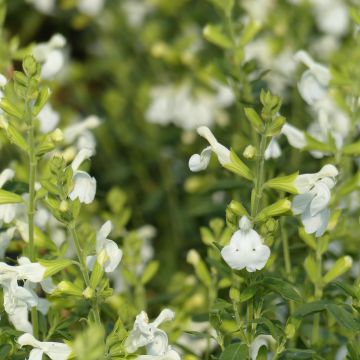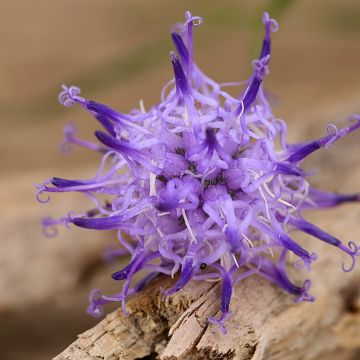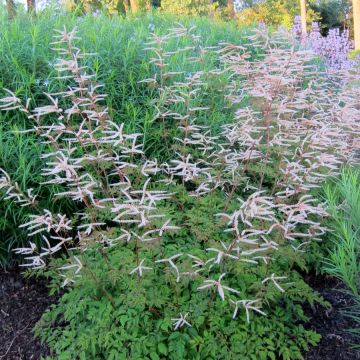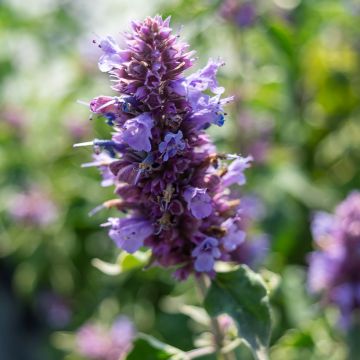

Salvia argentea


Salvia argentea


Salvia argentea


Salvia argentea


Salvia argentea
Salvia argentea
Salvia argentea
Silver Sage, Silver Clary
Young plant arrived in good condition. But it is very small compared to the picture on the website. I know it is a hardy plant and I hope it will recover well and flower next year.
Pascale, 28/09/2022
This item cannot be shipped to the selected country
Delivery charge from €5.90
Delivery charge from €5.90
Delivery to Corse prohibited
More information
Schedule delivery date,
and select date in basket
This plant carries a 12 months recovery warranty
More information
We guarantee the quality of our plants for a full growing cycle, and will replace at our expense any plant that fails to recover under normal climatic and planting conditions.
From €5.90 for pickup delivery and €6.90 for home delivery
Express home delivery from €8.90.
From €5.90 for pickup delivery and €6.90 for home delivery
Express home delivery from €8.90.
Delivery to Corse prohibited: UE law prohibits the import of this plant from mainland France to Corse as part of the fight against Xylella fastidiosa. Please accept our sincere apologies.
More information

Does this plant fit my garden?
Set up your Plantfit profile →
Description
The Salvia argentea, also known as Silver Sage, is a superb perennial or biennial botanical species appreciated primarily for its fabulous silver-clad foliage. It first forms a large rosette of ample evergreen, wavy, aromatic leaves covered in long bristles that turn white in summer. It flowers in the second year, in the form of a long upright stem bearing small white flowers. These are best removed before further seed formation to ensure the plant's longevity. This southern sage is hardy, but dislikes humidity and heavy soils. It requires full sun and perfectly drained soil, sandy or gravelly, even poor and calcareous.
The Salvia argentea is native to southern Europe and northwest Africa, from Turkey to the Balkan Peninsula, the Apennines, and the Iberian Peninsula. It grows naturally in loamy-gravelly soils, rich in limestone, in open environments (rockeries, steppes, and dry forests). This plant, like all salvias, belongs to the family of lamiaceae or labiates. Its growth habit is biennial, but will behave like a short-lived perennial if care is taken to prevent seed formation. The plant quickly forms a rosette that is 50 to 60 cm (20 to 24in) wide, composed of large oval, lobed, undulate leaves entirely covered in a long silver down. The foliage reaches a height of 20 to 30 cm (8 to 12in), with a diameter of about 60 cm (24in). The flowering, nectar-rich and honey-producing, appears in the second year of cultivation. The flowering stems, 70 to 80 cm (28 to 32in) tall, are branched. They are square-sectioned stems, bearing white flowers composed of two white lips. It is hardy in perfectly drained soil, to around -15°C (5°F). Small rosettes can appear on the periphery, also allowing the plant to perpetuate itself.
The Silver Sage can sometimes appear capricious, due to its dislike of stagnant humidity, especially in heavy, waterlogged soils in winter. It will thrive in a gravelled path border or in a raised bed with sandy or rocky soil reserved for authentic Mediterranean plants: lavender, rockroses, rosemary, myrtle. In a rockery, for example, it will accompany small drought-tolerant perennials such as soapwort, Californian poppies, creeping gypsophila, or Corsican carnation (Dianthus corsicus). Gauras, catananches, tall sedums (Sedum 'Matrona'), and shrubby potentillas will also create a charming scene alongside it.
With over 900 species of annuals, perennials, and soft-wooded shrubs distributed throughout the globe, except in very cold regions and the tropical forest, the genus Salvia is the richest in the lamiaceae family. The name Salvia, which dates back to Roman times, derives from the Latin salvus "healthy" in allusion to the medicinal properties of common sage.
Report an error about the product description
Salvia argentea in pictures


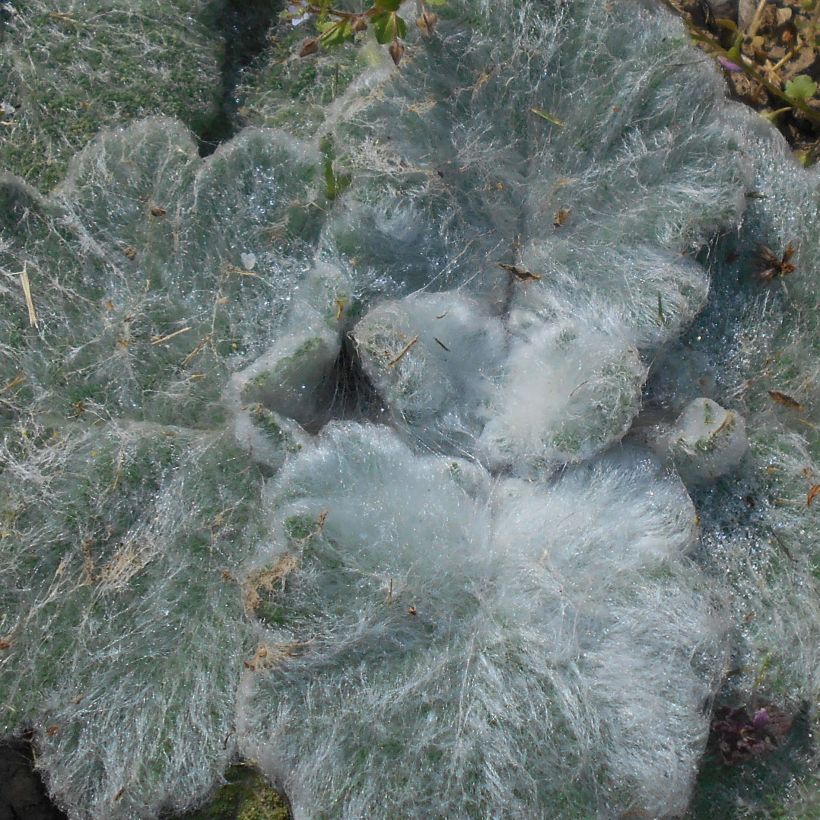

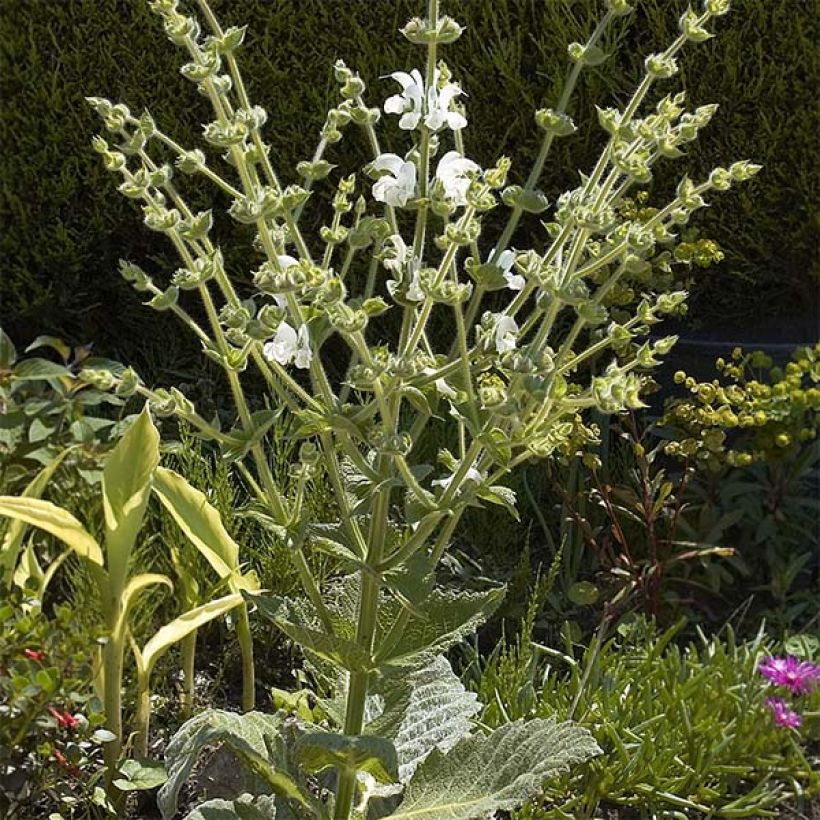

Flowering
Foliage
Plant habit
Botanical data
Salvia
argentea
Lamiaceae
Silver Sage, Silver Clary
Mediterranean
Other Salvia - Sage
Planting and care
Plant the Salvia argentea preferably after spring frosts in cold climates, in September-October in warm climates. Install it in a soil that is both sandy and humiferous, very light, not too rich. This plant thrives in very sunny situations. Cover the stump with glass plates throughout winter in cold regions, but let nature take its course in milder regions. Install this plant in the most sheltered corner from the wind, in a sandy slope, or any substrate that does not retain moisture, as this would be fatal to the plant in winter. Note that the growth of this sage is so fast that it can be perfectly cultivated as a biennial, by collecting the seeds at the end of summer; the plant easily self-seeds in light soil. Young shoots that may appear on the periphery of the mother rosette can also be separated and replanted a little further away, always in perfectly drained soil.
Planting period
Intended location
Care
-
, onOrder confirmed
Reply from on Promesse de fleurs
Summer flowering perennials
Haven't found what you were looking for?
Hardiness is the lowest winter temperature a plant can endure without suffering serious damage or even dying. However, hardiness is affected by location (a sheltered area, such as a patio), protection (winter cover) and soil type (hardiness is improved by well-drained soil).

Photo Sharing Terms & Conditions
In order to encourage gardeners to interact and share their experiences, Promesse de fleurs offers various media enabling content to be uploaded onto its Site - in particular via the ‘Photo sharing’ module.
The User agrees to refrain from:
- Posting any content that is illegal, prejudicial, insulting, racist, inciteful to hatred, revisionist, contrary to public decency, that infringes on privacy or on the privacy rights of third parties, in particular the publicity rights of persons and goods, intellectual property rights, or the right to privacy.
- Submitting content on behalf of a third party;
- Impersonate the identity of a third party and/or publish any personal information about a third party;
In general, the User undertakes to refrain from any unethical behaviour.
All Content (in particular text, comments, files, images, photos, videos, creative works, etc.), which may be subject to property or intellectual property rights, image or other private rights, shall remain the property of the User, subject to the limited rights granted by the terms of the licence granted by Promesse de fleurs as stated below. Users are at liberty to publish or not to publish such Content on the Site, notably via the ‘Photo Sharing’ facility, and accept that this Content shall be made public and freely accessible, notably on the Internet.
Users further acknowledge, undertake to have ,and guarantee that they hold all necessary rights and permissions to publish such material on the Site, in particular with regard to the legislation in force pertaining to any privacy, property, intellectual property, image, or contractual rights, or rights of any other nature. By publishing such Content on the Site, Users acknowledge accepting full liability as publishers of the Content within the meaning of the law, and grant Promesse de fleurs, free of charge, an inclusive, worldwide licence for the said Content for the entire duration of its publication, including all reproduction, representation, up/downloading, displaying, performing, transmission, and storage rights.
Users also grant permission for their name to be linked to the Content and accept that this link may not always be made available.
By engaging in posting material, Users consent to their Content becoming automatically accessible on the Internet, in particular on other sites and/or blogs and/or web pages of the Promesse de fleurs site, including in particular social pages and the Promesse de fleurs catalogue.
Users may secure the removal of entrusted content free of charge by issuing a simple request via our contact form.
The flowering period indicated on our website applies to countries and regions located in USDA zone 8 (France, the United Kingdom, Ireland, the Netherlands, etc.)
It will vary according to where you live:
- In zones 9 to 10 (Italy, Spain, Greece, etc.), flowering will occur about 2 to 4 weeks earlier.
- In zones 6 to 7 (Germany, Poland, Slovenia, and lower mountainous regions), flowering will be delayed by 2 to 3 weeks.
- In zone 5 (Central Europe, Scandinavia), blooming will be delayed by 3 to 5 weeks.
In temperate climates, pruning of spring-flowering shrubs (forsythia, spireas, etc.) should be done just after flowering.
Pruning of summer-flowering shrubs (Indian Lilac, Perovskia, etc.) can be done in winter or spring.
In cold regions as well as with frost-sensitive plants, avoid pruning too early when severe frosts may still occur.
The planting period indicated on our website applies to countries and regions located in USDA zone 8 (France, United Kingdom, Ireland, Netherlands).
It will vary according to where you live:
- In Mediterranean zones (Marseille, Madrid, Milan, etc.), autumn and winter are the best planting periods.
- In continental zones (Strasbourg, Munich, Vienna, etc.), delay planting by 2 to 3 weeks in spring and bring it forward by 2 to 4 weeks in autumn.
- In mountainous regions (the Alps, Pyrenees, Carpathians, etc.), it is best to plant in late spring (May-June) or late summer (August-September).
The harvesting period indicated on our website applies to countries and regions in USDA zone 8 (France, England, Ireland, the Netherlands).
In colder areas (Scandinavia, Poland, Austria...) fruit and vegetable harvests are likely to be delayed by 3-4 weeks.
In warmer areas (Italy, Spain, Greece, etc.), harvesting will probably take place earlier, depending on weather conditions.
The sowing periods indicated on our website apply to countries and regions within USDA Zone 8 (France, UK, Ireland, Netherlands).
In colder areas (Scandinavia, Poland, Austria...), delay any outdoor sowing by 3-4 weeks, or sow under glass.
In warmer climes (Italy, Spain, Greece, etc.), bring outdoor sowing forward by a few weeks.





































